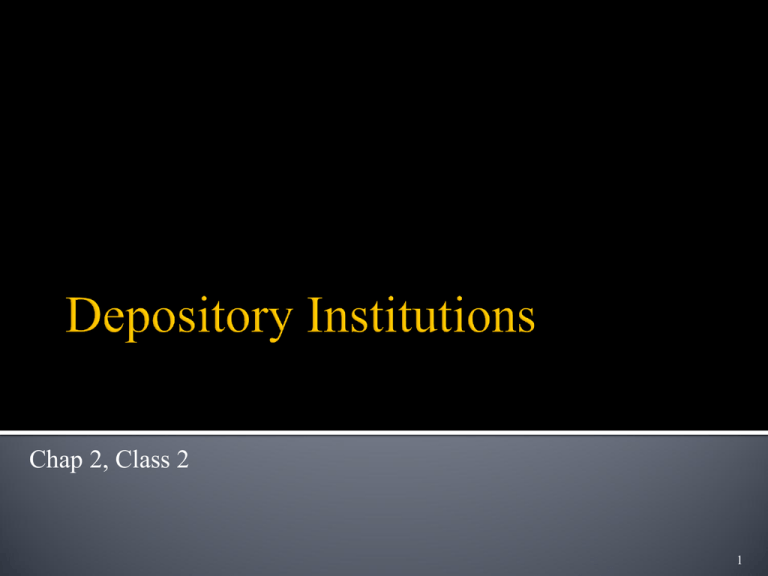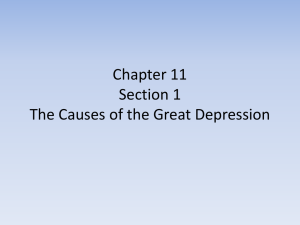Depository Institutions
advertisement

Chap 2, Class 2 1 Purpose: Introduce different types of Depository Institutions and provide an overview of their functions and history Outline: Different types of depository institutions Commercial banks Savings institutions Savings & Loans Savings Banks Credit unions 2 Different Types of Depository Institutions 3 Commercial Banks: Generally large banks that offer a wide range of services Usually service larger clients Savings Institutions Generally smaller banks that offer fewer services Usually service smaller clients Credit Unions Generally smaller institutions that specialize in personal banking for a select group of clients (depositors) who also own the bank Savings Banks: Operate as a more diversified savings institution Savings & Loan: Traditionally focus on mortgage lending 7 Owned by depositors Accept deposits in the form of shares Lend to members Mainly smaller consumer loans 8 COMMERCIAL BANKS 9 Equity Capital = 1,500.7 Equity Capital = 137.06 Equity Capital = 104.8 Commercial Banks are by far the largest Depository Institutions Services: Checking and deposit accounts – attract deposits Consumer and residential lending Commercial and industrial lending (C&I loans) In General: Commercial banks provide a wider array of services to customers than other DIs 11 Source: FDIC Quarterly Banking 12 Source: FDIC Quarterly Banking 13 1. Struggling financial sector Started in the 1980s – the banking sector was hit by high inflation (prime rate > 20%) Meant to allow DIs to better compete with non-DI financial institutions Deregulation Acts ▪ 1980 Depository Deregulation and Monetary Control Act (DIDMCA) – (allowed banks to merge) ▪ 1982 Garn-St. Germain Depository Institution Act (DIA) ▪ Competitive Equality in Banking Act Regulatory Changes 2. 1994 Riegle-Neal Interstate Banking and Branching Efficiency Act – Allowed bank holding companies to acquire banks in other states Big bank mergers Bank of America and FleetBoston ($47 billion in 2003) J.P. Morgan Chase & Bank One ($60 billion in 2004) 14 How did the merger wave change the industry? % small banks % large banks Number of banks Under 100 mill Over 1 bill 1984 2012 Smallest banks % of total 83.2% 33% Small bank % of total 14.9% 58.5% Large Banks % of total 1.9% 8.5% Share of Financial Assets 1984 2012 Smallest banks % of total 16.1% 0.9% Small bank % of total 20.5% 8.1% Large Banks % of total 63.4% 91% Asset share at small banks Asset share at large banks 85 banks controlled 79.9% of financial sector assets 15 Average size of banks has been increasing due to mergers. Large banks often rely on quantitative information (factual financial info.) on their borrowers lend to larger borrowers. Small banks focus on relationship lending (qualitative information) lend to smaller borrowers The effect of large bank mergers on credit availability to small businesses? Large firms have access to capital markets (through commercial paper and corporate bonds). Small business financing became more difficult to obtain 16 A Commercial Bank Business Loans (C&I Loans) L Transaction Deposits Non-transaction Deposits Securities Real Estate Loans Consumer Loans Subordinated Debt (issued only by large banks) Equity Capital (Net worth) 17 C&I Loans (10.72%): Loans to businesses, not secured by real estate. These loans are generally illiquid due to the information collection and monitoring services of banks. Securities (29.91%): Mainly: U.S. Treasuries Municipal bonds Investment grade corporate bonds Real Estate Loans (27.31%): Commercial loans to businesses that are secured by real estate Residential loans (e.g. home mortgages). They are becoming increasingly liquid due to securitization! Consumer Loans (13.97%): Credit cards; auto loans; student loans; etc. 18 19 20 Transaction Deposits: They are deposits that you can write a check against; the most liquid kind of deposits (on average 8% of total liabilities in 2009). Demand Deposits(): ▪ The bank must give you your funds on demand and cannot pay interest on them (regulation). ▪ They are insured by the regulator (FDIC). ▪ Banks hold a certain % of them on reserve at the FED. NOW (Negotiable Order of Withdrawal) Accounts: ▪ They pay interest but revert to the status of a demand deposit if the funds fall below a minimum balance. 21 Non-transaction Deposits (on average 56% in 2009): Passbook Savings and Money Market Deposit Accounts: ▪ Pay interest and are liquid since the holder can withdraw funds anytime. ▪ MMDAs have limitations on the number of transactions and generally have a minimum balance requirements. Time Deposits: ▪ Pay higher interest but are less liquid than MMDAs and passbook accounts (with maturities of at least 14 days). Negotiable CDs: ▪ Time deposits with a value greater than $100,000 (this is the cut-off to be fully insured by FDIC) ▪ They are traded in the secondary market just like bonds. 22 Subordinated Debt: Large banks may issue longer-maturity publicly-traded bonds. They are subordinate (junior) to the bank’s other liabilities (for regulatory reasons). Issued only by large banks. Capital (Net worth): Difference between bank assets and liabilities. It is important as a buffer to prevent bankruptcy. Banks must hold minimum 8% of their risk weighted assets as capital. 23 Activities that are not reported on the balance sheet but are moved back on when a contingent event occurs. Examples: letter of credit, derivative contracts, loan commitments. Can be used to avoid regulatory costs and taxes. Can be used to hedge interest rate, credit and FX risks. Can significantly increase risk exposure!!!! 24 Federal Charter State Charter OCC State Agency Primary Supervisor Primary Supervisor Chose to be part of the Federal Reserve System Federal Reserve Chose to not to be part of the Federal Reserve System FDIC Charter determines a banks power, capital requirements and lending limits 25 Savings Institutions 26 Savings & Loans (Thrifts): Traditionally focus on mortgage lending • Main functions: • Accept Deposits • Lend funds in several forms but mainly residential mortgages Savings Banks: Operate as a more diversified saving institution • Main functions: • Accept Deposits • Lend funds in many forms: • • • • Residential mortgages Commercial and Industrial Loans (C&L) Corporate Bonds Stocks Functions Established primarily to serve personal savers – collect short-term deposits and use them to make residential mortgage loans Today they perform services similar to commercial banks (but must hold at least 65 % of their assets as mortgages or mortgage-backed securities) – only Savings and Loans (thrifts) Many thrifts began as mutual organizations that were legally owned by their depositors. Recently, they have converted to stock-issuing institutions and therefore they raise equity from public investors. 28 Both Saving Banks and Savings & Loans are chartered by: Federally – The Office of the Comptroller of Currency (OCC) State Originally: Deposits: ▪ Savings Banks – Federal Deposit Insurance Corp. (FDIC) ▪ Savings & Loans – Federal Savings & Loans Insurance Corp (FSLIC) Savings banks were limited by law to only offer savings accounts and to make their income from mortgages and student loans. Management at Savings & Loans is determined by depositors ▪ The weight of each depositor’s vote depends on the percent of bank funds deposited by the individual 29 Currently: Changes in bank regulation have made the operations of these two banks almost indistinguishable The main difference between the two is that management in an S&L is determined by depositors 30 S&L Crisis 1980’s Increasing interest rates due to monetary and foreign policy exposed S&Ls to severe interest rate risk S&Ls were locked into long-term mortgages that paid fixed interest rates The rates on short-term deposits adjusted upward so S&Ls faced a negative margin Recapitalized FSLIC Margin = r(mortgage) – r(deposits) Replaced FSLIC with FDIC Excessive risk taking in lending (gambling for resurrection) Federal Savings and Loan Insurance Corporation (FSLIC) – the insurance provider for S&L deposits suffered severe capital shortages ▪ 1987 Competitive Equality in Banking Act ▪ 1989 Financial Institutions Reform Recovery and Enforcement Act FIRREA 31 Real estate fall out Real estate in Texas and the Southwest collapsed S&Ls were exposed to a large number of defaults Their numbers decreased by 35% during the 1980’s There were about 1,300 S&Ls as of 2006 year-end. Deposit insurance cost of these failures exceeded $160B. Now they are under the regulation of FDIC and pay risk-based deposit insurance premiums. Savings Banks Mainly located on the East Coast Location insulated banks against large losses in real estate values in the southwest 32 1990-1991 real estate fallout in New England Real estate market crash severely affected Savings Banks 33 34 Financial Institution Reform and Recovery Act 1989 Abolished Federal Savings and Loan Insurance Corporation (FSLIC) Created Savings Association Insurance Fund (SAIF) – (FDIC managed) Created Resolution Trust Corp. to close the most insolvent SIs Restricted SIs non-mortgage related asset holdings Federal Deposit Insurance Corporation Improvement Act 1991 Introduced risk-based depository insurance premiums Introduced regulatory intervention whenever bank capital falls below a certain point Limited the use of too-big-to fail bailouts Extended federal regulation to branches of foreign banks 35 Cash and due forms US Treasuries Mortgage loans MBS Bonds and notes Commercial loans Consumer loans 9.58% 0.56% 44.88% 20.75% 5.12% 4.66% 7.65% 36 Total Deposits Other Borrowing Fed Repurchase Agreements Other Liabilities Net worth (capital) 76.48% 7.23% 2.68% 1.72% 11.89% 37 Federal Charter State Charter State Agency OCC Primary Supervisor Formerly regulated by the Office of Thrift Supervision 2011 OTS was consolidated with OCC Saving & Loan Federal Reserve Saving Bank FDIC Charter determines a banks power, capital requirements and lending limits 38 Credit Unions 39 Non-profit depository institutions, owned by their members. Investors paid an entrance fee and invested funds to buy at least one share CUs lend the deposited funds to other members Limited customer base (only members – common attribute) Profession Residential location Affiliation (University) Generally charge lower rates to members and pay higher rates to depositors – from non-profit status 40 Cash equivalents US Gov. securities MBS Corporate Bonds Other investment securities Home Mortgages Consumer Credit Business Loans Other loans 4.3% 19.9% 4.9% 2.0% 3.5% 28.1% 23.8% 4.0% 4.7% 41 Share drafts Small time and savings shares Large time deposits Misc. liabilities Net worth (capital) 10.8% 67.9% 7.2% 3.8% 10.3% 42 Question: how do Credit Unions make their profits? Answer: They don’t !!!!! ▪ Credit Unions are non-profit organizations, so they take the money they earn on loans and distribute it to their owners – the depositors ▪ They only take what they need to cover costs. This allows them to pay higher rates on deposits and charge lower rates on loans 43 Federal Charter National Credit Union Administration Deposits insured by the National Credit Union Insurance Fund State Charter State Agency Primary Supervisor Deposits may be insured by the National Credit Union Insurance Fund 44 Depositor Institution Comparison 45 Depository Institution Asset Distributions 100% 90% other assets 80% consumer loans 70% commercial loans (C & L) 60% Investment Securities Mortgage Loans 50% US Treasury securities 40% Cash 30% 20% 10% 0% Commercial Banks Savings Insitutions Credit Unions Total Liabilities 100% 90% 80% Other Liabilities 70% Borrowing 60% Total Deposits 50% 40% 30% 20% 10% 0% Commercial Banks Savings Insitutions Credit Unions In 2009: All three types of DIs have the largest fraction of their assets in mortgages Commercial banks have a large fraction of their business in C&I loans Commercial banks use investment securities more than other DIs Commercial banks are more diversified Credit unions are more customer oriented (more consumer loans) Savings banks focus on residential mortgages The main source of funding for all three banks is deposits Different types of Depository Institutions Commercial Banks Savings Institutions Credit Unions Functions Assets Liabilities History (trends) Merger wave S&L Crisis 49








